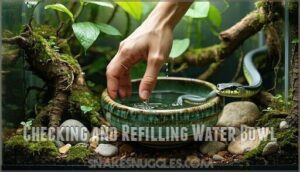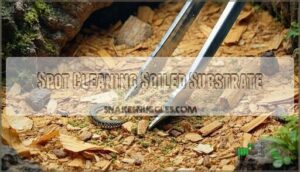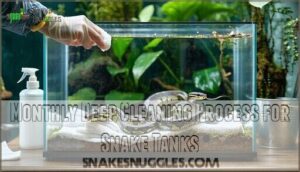This site is supported by our readers. We may earn a commission, at no cost to you, if you purchase through links.

Start with daily spot cleaning—remove waste, check water, and inspect substrate.
Weekly tasks include wiping tank walls, replacing soiled bedding, and disinfecting accessories.
Monthly deep cleans require removing everything, sanitizing the entire enclosure, and checking for damage.
Always use reptile-safe cleaners and rinse thoroughly.
Wear gloves and maintain proper ventilation during cleaning.
The frequency depends on your snake’s size, feeding schedule, and substrate type.
Proper snake cage cleaning prevents bacterial growth, controls odors, and maintains ideal humidity levels.
Mastering the right cleaning schedule and techniques can transform your snake’s habitat into a pristine environment that promotes longevity.
This is achieved by following a consistent cleaning routine, using the right materials, and being mindful of your snake’s specific needs, ensuring a healthy and stress-free life for your pet.
Table Of Contents
- Key Takeaways
- Why Clean Your Snake’s Enclosure Regularly?
- Essential Supplies for Snake Cage Cleaning
- Daily Snake Tank Maintenance Routine
- Weekly Snake Enclosure Cleaning Tasks
- Monthly Deep Cleaning Process for Snake Tanks
- Common Snake Cage Cleaning Mistakes to Avoid
- Frequently Asked Questions (FAQs)
- How do you clean a snake cage?
- Does white vinegar clean snake cages?
- What should I use to clean my reptile’s cage?
- How often should you clean a snake cage?
- How do you clean a snake enclosure?
- Can you use dish soap to clean a snake cage?
- How often should a snake cage be cleaned?
- What is the best cleaner for snake cages?
- How often should you change the bedding in a snake tank?
- Can I use vinegar to clean my reptile cage?
- Conclusion
Key Takeaways
- Clean daily to prevent bacterial buildup – You’ll need to spot-clean waste immediately and check water bowls to stop dangerous bacteria like Salmonella from thriving in your snake’s warm, humid environment.
- Use only reptile-safe cleaning products – You must avoid household cleaners containing ammonia or harsh chemicals that can poison your snake through skin absorption, and always rinse thoroughly after disinfecting.
- Follow a structured cleaning schedule – You should do daily spot cleaning, weekly maintenance (wiping walls, replacing soiled substrate), and monthly deep cleans for optimal snake health.
- Don’t neglect hiding spots and accessories – You need to clean all cage furniture, decorations, and hard-to-reach areas where bacteria accumulate, as these overlooked spots can become dangerous breeding grounds for pathogens.
Why Clean Your Snake’s Enclosure Regularly?
You’ll need to clean your snake’s enclosure regularly to prevent dangerous bacteria like Salmonella from building up in the warm, humid environment your pet requires.
Regular cleaning also maintains proper humidity levels, eliminates waste odors, and reduces stress on your snake by keeping its habitat comfortable and healthy.
Preventing Bacterial Growth and Disease
Beyond the surface mess, snake cage cleaning serves as your primary weapon against bacterial growth and disease prevention.
Dirty enclosures create perfect breeding grounds where harmful pathogens multiply rapidly, threatening your snake’s health through scale rot, parasite control issues, and zoonotic risks like Salmonella prevention concerns.
A dirty snake cage becomes a dangerous pathogen factory threatening your pet’s survival.
- Bacteria thrive in warm, moist snake habitats at 75°F and 50% humidity
- Salmonella lurks in feces and urates, creating serious zoonotic risks
- Scale rot develops when substrate stays wet and contaminated too long
- Parasite control fails without proper disinfectant use and waste removal
- Immune support weakens as pathogens overwhelm your snake’s natural defenses
Maintaining Proper Humidity Levels
Regular snake cage cleaning directly impacts humidity control in your reptile enclosure. Clean substrate prevents moisture buildup that creates bacterial breeding grounds, while proper ventilation control becomes easier to manage.
Fresh bedding allows accurate humidity monitoring and supports shedding success by maintaining consistent levels. For example, tropical snakes need higher humidity levels than desert species.
| Cleaning Aspect | Humidity Impact |
|---|---|
| Substrate Choice | Controls moisture retention |
| Ventilation Control | Prevents excess humidity |
| Misting Systems | Works better in clean tanks |
| Regular Maintenance | Guarantees stable levels |
Reducing Stress on Your Snake
Snakes experience snake stress when their environment feels chaotic or unpredictable. Clean habitats promote calm snake behavior by eliminating disruptions that trigger predator avoidance responses.
Proper stress reduction requires consistent maintenance routines, including considerations for the snake’s environment and handling. The following practices are essential:
- Quiet Environment during cleaning minimizes disturbance
- Temporary Enclosures provide snake safety during deep cleaning
- Gentle Handling reduces anxiety when relocating your pet
- Gradual Reintroduction with Familiar Scents eases shifts back
Eliminating Odors and Waste Buildup
Nobody wants a smelly snake cage! Proper odor elimination and waste management keep your enclosure fresh and your snake healthy.
Daily spot cleaning prevents buildup, while smart substrate choice controls lingering smells. Good ventilation improves air quality and reduces humidity-related odors.
Your cleaning frequency directly impacts snake cage hygiene.
- Odor Prevention: Remove waste immediately to stop bacterial growth and smell development
- Substrate Choice: Paper towels absorb odors better than wood chips for easy cleanup
- Air Quality: Proper ventilation prevents stagnant air that traps unpleasant smells
- Waste Management: Daily removal of feces and urates maintains a fresh-smelling habitat
Ensuring Optimal Health for Your Pet
Clean enclosures are your snake’s first line of defense against illness.
Proper snake cage hygiene prevents disease prevention issues like scale rot and respiratory infections.
Regular maintenance supports your pet’s immune system while stress reduction comes from consistent, clean environments.
You’ll spot health problems early through routine cleaning and disinfection, giving your reptile health the best foundation for thriving.
Essential Supplies for Snake Cage Cleaning
Having the right cleaning supplies transforms snake cage maintenance from a chore into a straightforward routine.
You’ll need specific products designed for reptile environments to keep your pet healthy and safe.
Here are the essential cleaning supplies you need:
- Safe Disinfectants – F10 veterinary disinfectant or chlorhexidine for killing germs without harming your snake
- Cleaning Tools – Scrub brushes, sponges, and tweezers for removing waste and stubborn debris
- Protective Gear – Disposable gloves and hand sanitizer to protect yourself from pathogens
- Substrate Options – Fresh bedding materials ready for immediate replacement after deep cleaning
Stock up on paper towels, spray bottles for applying disinfectant solutions, and designated cleaning products exclusively for your snake’s enclosure.
Remember that cleaning removes debris, which is a necessary step before disinfecting.
Never use household cleaners containing ammonia or harsh chemicals, as these can harm your pet.
Keep waste disposal bags handy for contaminated substrate removal.
Store all snake cage cleaning supplies separately from other household items to prevent cross-contamination and make certain you’re always prepared for routine maintenance.
Daily Snake Tank Maintenance Routine
Daily maintenance keeps your snake healthy and prevents problems before they start.
You’ll spend just a few minutes each day checking for waste, refilling water, and watching for any changes in your pet’s behavior or appearance.
You’ll also be watching for any changes in your pet’s behavior.
Removing Feces and Urates
Within your snake’s enclosure, feces identification becomes vital for daily cleaning routines.
You’ll spot dark, solid waste alongside white, chalky urates—your snake’s version of urine.
Daily feces removal prevents bacterial buildup that thrives in warm, humid conditions.
Regular cleaning is important because humid conditions promote germ and bacteria growth.
Use tongs for spot cleaning, removing waste plus surrounding substrate within an eight-inch radius.
This hygiene practice guarantees effective disease prevention while maintaining your pet’s health.
Checking and Refilling Water Bowl
Daily water bowl hygiene forms the foundation of proper pet snake care. Fresh water prevents bacterial growth that thrives in stagnant conditions.
Check your snake’s water bowl daily for debris, mineral buildup, or contamination.
Here’s your water bowl cleaning routine:
- Wash daily – Use hot water and unscented dish soap to remove biofilm
- Scrub thoroughly – A dedicated brush eliminates stubborn residue and prevents cross-contamination
- Rinse completely – Remove all soap traces before refilling with dechlorinated water
Choosing the right bowl is important, so explore different snake water bowl options. Bowl material affects cleaning frequency and disinfectant options.
Inspecting for Signs of Illness or Injury
During your daily water changes, carefully observe your snake for potential health conditions. Look for skin abnormalities like incomplete sheds, lesions, or unusual discoloration on scales.
Watch for respiratory signs including wheezing, mouth breathing, or nasal discharge. Monitor behavioral changes such as lethargy or unusual positioning.
Note appetite changes beyond normal shedding periods. Conduct thorough injury assessment by checking for cuts or swelling.
Early detection through consistent snake health inspection supports ideal pet snake health and enables prompt veterinary intervention when needed. Consider a complete snake first-aid for thorough care.
Spot Cleaning Soiled Substrate
After checking your snake for health issues, you’ll need to tackle any messes in the enclosure.
Spot cleaning soiled substrate means removing contaminated bedding immediately when you find waste or spilled water.
Use tweezers or a small scoop to extract urates and feces along with surrounding dirty substrate. A substrate scoop purchase can make this task easier.
This targeted substrate replacement prevents bacterial growth, controls odors, and maintains your snake habitat between full cleanings.
Weekly Snake Enclosure Cleaning Tasks
Weekly cleaning tasks build on your daily maintenance routine to keep your snake’s environment consistently healthy.
These mid-level cleaning activities help prevent the buildup of bacteria and waste that daily spot cleaning might miss, which is crucial for maintaining a healthy environment for your snake, emphasizing the importance of regular cleaning.
Wiping Down Tank Walls and Decorations
Weekly maintenance keeps your snake’s environment pristine and healthy. Start by removing decaying plants and toys that harbor bacteria and create unpleasant odors.
Follow these essential scrubbing techniques for ideal tank walls cleaning:
- Use reptile-safe disinfectant with soft cloths to prevent scratches on glass surfaces
- Wipe all decorations sanitizing rocks, branches, and hiding spots thoroughly
- Check material compatibility before applying cleaning solutions to prevent damage
- Allow complete drying methods before reassembling to avoid chemical exposure
- Focus on corners where waste accumulates for effective snake cage cleaning
This routine prevents bacterial growth while maintaining your pet’s comfort. It is crucial to perform these tasks regularly to ensure a clean and safe environment for your snake, promoting its overall health and wellbeing.
Replacing Soiled Substrate
Substrate disposal requires careful attention to maintain your snake’s health. Weekly replacement prevents bacterial buildup and odor issues that develop in soiled areas. You’ll notice substrate changes color or smell when it needs changing.
- Substrate types: Choose species-appropriate options like aspen shavings, cypress mulch, or paper towels based on your snake’s burrowing habits
- Spot cleaning: Remove waste-soiled substrate within an 8-10 inch radius immediately, replacing with fresh material
- Deep cleaning frequency: Replace all substrate weekly, though messy species may need more frequent changes
Fresh substrate maintains proper humidity levels and prevents mold growth.
Disinfecting Water Bowl and Accessories
Your water bowl needs weekly attention to prevent bacterial growth and mineral buildup.
Remove the bowl and reptile-safe disinfectants like diluted chlorhexidine work best for thorough cleaning. Use gentle scrubbing techniques with a soft brush, avoiding scratches that harbor bacteria.
Material considerations matter—plastic bowls require extra care.
To maintain proper hygiene, consider that daily cleaning is essential for removing debris and preventing bacterial growth.
Rinse thoroughly after disinfection, then apply proper drying methods before refilling with fresh water.
Checking Temperature and Humidity Levels
With your accessories sparkling clean, it’s time to verify your snake’s environmental conditions are spot-on.
Weekly temperature monitoring and humidity checks guarantee your pet thrives in ideal conditions.
- Temperature Gradient: Maintain 75-85°F with proper thermostat calibration
- Humidity Monitoring: Keep levels at 50-70% using accurate hygrometer placement
- Snake Tank Temperature: Check both warm and cool zones consistently
- Seasonal Adjustments: Modify temperature requirements as room conditions change
Monthly Deep Cleaning Process for Snake Tanks
While weekly cleaning handles routine maintenance, monthly deep cleaning tackles the bacteria and buildup that accumulate over time in your snake’s habitat.
This thorough process involves temporarily relocating your snake and completely revitalizing their environment to prevent health issues and maintain ideal living conditions, which is crucial for the snake’s well-being, and involves a process that is thorough, making it a complete concept.
Removing and Sanitizing All Accessories
First, carefully lift out all cage furniture and decorations from your snake’s enclosure.
Sanitize each item using reptile-safe disinfectant, paying attention to material considerations—plastic accessories need gentle scrubbing techniques while wooden items require longer accessory soak time.
Choose appropriate disinfectant types for different cleaning materials. Scrub thoroughly with cleaning products, then focus on drying thoroughly before storage.
This accessory disinfection step guarantees your snake’s environment stays pristine.
Thoroughly Cleaning and Disinfecting The Tank
Once you’ve safely relocated your snake, it’s time to tackle the tank itself.
The cleaning and disinfection process requires attention to detail and proper airing duration.
- Scrub all surfaces with hot, soapy water using reptile cage cleaner
- Apply snake cage disinfectant to eliminate bacteria and germs completely
- Rinse thoroughly with hottest water possible to remove all residue
- Allow complete air drying for proper component inspection and safety
- Inspect for damage before reassembling your snake’s habitat
To maintain animal health, it’s also important to keep a logbook of tank conditions.
Replacing All Substrate
Complete substrate disposal starts with removing every bit of old material from your snake tank.
Choosing substrate depends on your snake’s needs and your cleaning preferences.
Pour new substrate to proper substrate depth – typically 1-2 inches for most substrate types.
Make certain everything’s completely dry before adding fresh material, preventing mold growth in your clean environment.
Inspecting and Repairing Tank Components
During monthly deep cleaning, examine your snake tank components for potential issues.
Check seal integrity around glass joints and hinge maintenance on doors. Verify lock security mechanisms function properly.
Inspect cord condition for fraying or damage. Test your heat element for consistent operation.
Address worn cage components immediately during snake tank inspection. Proper snake tank repair prevents costly emergencies and maintains your snake’s safety during routine snake cage cleaning.
Common Snake Cage Cleaning Mistakes to Avoid
Even experienced snake owners can make costly cleaning mistakes that harm their pet’s health. Avoiding these common errors will keep your snake safe and your enclosure properly maintained.
Using Harsh or Toxic Cleaning Agents
Many snake owners make the dangerous mistake of using toxic cleaning agents that can poison their pets.
Household cleaners contain chemicals that are deadly to snakes through skin absorption and respiratory exposure. Even "natural" products can be harmful.
Safe alternatives like reptile-specific disinfectants protect your snake from residue dangers while maintaining proper hygiene.
- Product ingredients matter – avoid ammonia, bleach, phenols, and pine-based cleaners that cause respiratory distress
- Snake sensitivity to chemicals is extreme – their permeable skin absorbs toxins rapidly, leading to illness or death
- Proper ventilation during cleaning with safe cleaning products prevents chemical buildup in enclosed spaces
Neglecting to Rinse Thoroughly After Cleaning
Thorough rinsing after snake cage cleaning prevents residue dangers and protects your pet from chemical exposure.
Cleaning products and disinfectants can leave harmful traces that cause skin irritation or poisoning. Poor water quality from leftover chemicals directly impacts snake health.
The rinsing importance can’t be overstated – use hot water to eliminate all traces of toxic cleaning agents. Double-check every surface for complete residue rinsing before returning your snake.
Cleaning Too Frequently or Infrequently
Finding the right Cleaning Balance prevents both Over-cleaning Risks and Under-cleaning Dangers.
Cleaning frequency varies by Species Variation – ball pythons need less frequent cleaning than corn snakes.
Tailored Schedules work best: daily spot-cleaning, weekly maintenance, monthly deep-cleans.
To maintain hygiene, it’s important to remove waste daily.
Your snake cage cleaning schedule should match your pet’s habits and substrate type for ideal snake tank cleaning frequency.
Forgetting to Clean Hiding Spots and Accessories
Hidden spots harbor bacteria that you can’t see. These overlooked areas become breeding grounds for dangerous microorganisms if you skip them during cleaning snake cage routines.
Your snake’s life depends on what you can’t see lurking in forgotten corners.
- Water bowls and food dishes – Clean weekly with hot soapy water to prevent accessory bacterial buildup
- Hiding caves and logs – Scrub porous material risks like wood that absorbs waste and moisture
- Rock crevices and decorations – Use brushes to reach tight spaces where overlooked mold growth thrives
- Substrate around tank edges – Replace material near hiding spots cleaning areas completely
- Artificial plants and branches – Deep clean decor monthly to eliminate hidden contamination zones
Frequently Asked Questions (FAQs)
How do you clean a snake cage?
Ready to tackle the not-so-glamorous side of snake ownership? Remove your snake, discard old substrate, scrub surfaces with reptile-safe disinfectant, replace bedding, clean accessories thoroughly, and return your snake.
Does white vinegar clean snake cages?
White vinegar can clean snake cages effectively.
You’ll want to dilute it with water (1:1 ratio) since straight vinegar’s too acidic.
It disinfects surfaces naturally and removes mineral deposits from water bowls safely.
What should I use to clean my reptile’s cage?
You’ll need reptile-safe disinfectants, hot soapy water, and sturdy cleaning tools like brushes and sponges. Clean weekly with thorough disinfection, replacing substrate and washing all accessories completely.
How often should you clean a snake cage?
You’ll need to spot-clean daily by removing waste and replacing soiled substrate, then perform deep cleaning every 4-6 weeks with complete substrate replacement and disinfection.
How do you clean a snake enclosure?
Like scrubbing a canvas clean, relocate your snake first. Remove accessories, discard old substrate, clean surfaces with reptile-safe disinfectant, rinse thoroughly, dry completely, then reassemble with fresh substrate.
Can you use dish soap to clean a snake cage?
Yes, you can use dish soap to clean your snake’s cage.
Choose antibacterial dish soap and mix it with hot water for effective cleaning.
Rinse thoroughly afterward to remove all soap residue before returning your snake.
How often should a snake cage be cleaned?
Monthly deep cleans contrast with daily spot-cleaning needs.
You’ll remove waste and clean water bowls weekly, but complete substrate replacement and thorough disinfection should happen every 4-6 weeks depending on your snake’s messiness.
What is the best cleaner for snake cages?
Use reptile-safe disinfectants or diluted bleach solution (1:10 ratio) with hot, soapy water. You’ll need antibacterial soap, paper towels, and scrubbing brushes for thorough cleaning.
How often should you change the bedding in a snake tank?
Coincidentally, your snake’s natural shedding cycle aligns perfectly with bedding replacement needs.
Replace substrate monthly during deep cleaning, but spot-clean daily by removing waste and soiled areas immediately to maintain hygiene.
To maintain hygiene.
Can I use vinegar to clean my reptile cage?
Vinegar isn’t recommended for reptile cages because it’s acidic and can irritate your snake’s respiratory system.
Instead, you’ll want reptile-safe disinfectants that effectively kill bacteria without creating harmful fumes or residues.
Conclusion
Studies show that proper habitat maintenance can extend a snake’s lifespan by up to 30% compared to poorly maintained enclosures.
Consistent snake cage cleaning creates the foundation for your pet’s long-term health and happiness. You’ve learned that daily spot cleaning, weekly maintenance, and monthly deep cleans work together to prevent disease and reduce stress.
Remember to always use reptile-safe products and rinse thoroughly after each cleaning session. Your snake will thrive in a clean environment that mimics their natural habitat conditions perfectly.
- https://aminoapps.com/c/reptiles/page/item/how-to-clean-your-snake-enclosure/WJdV_d3rIVIL0gVNXN374Ra885WlveZEd6w
- https://www.tampavet.com/exotics-blog/cleaning-reptiles-habitat/
- https://www.marriottsvillevet.com/2019/03/01/ellicott-city-md-vet-cleaning-reptile-cage/
- https://www.environment.nsw.gov.au/sites/default/files/2024-06/captive-snakes-hygiene-protocol-disease-control.pdf
- https://familysnake.com/guides/how-often-should-the-enclosure-of-a-corn-snake-be-cleaned/













